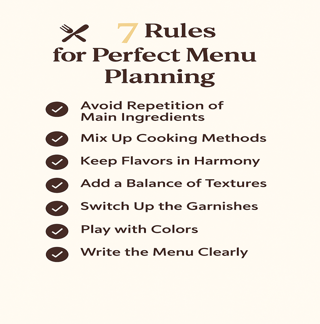
Planning a menu may sound simple, but when you actually sit down to put dishes together, it can get tricky. The secret isn’t just cooking your favorite recipes — it’s about variety, balance, and creating a flow that makes the meal feel complete.
I remember one day in particular. A few weeks ago, I was preparing for a small get-together at home. Excited, I quickly jotted down my favorite dishes — chicken curry, fried chicken, butter chicken, and a chicken starter. When I looked at the list, I burst out laughing — I had just created an all-chicken menu! 🐔
That’s when I realized: good menu planning means more than just listing favorites. It’s about keeping flavors, textures, and colors interesting throughout the meal. So, I reworked my plan. I kept the chicken curry as the star, added a refreshing salad, a paneer dish for my vegetarian friends, and a colorful dessert to finish.
The result was amazing — the table looked vibrant, the flavors balanced each other, and everyone enjoyed the meal without feeling too heavy. That day, I truly understood the value of the 7 golden rules of menu planning. 🌟
And here’s the good news — these rules are simple, practical, and work for every occasion, whether you’re planning a festive dinner, a casual weekend meal, or even a weekly family menu. Let’s dive in!
1. Avoid Repetition of Main Ingredients
Don’t serve the same meat or poultry twice. For example, if your starter has chicken, choose fish, lamb, or vegetarian for the main course. This keeps the menu exciting.
2. Mix Up the Cooking Methods
Vary how your dishes are prepared. A poached fish starter shouldn’t be followed by poached chicken. Balance grilled, roasted, sautéed, and steamed options for variety.
3. Create Flavor Harmony
Each course should complement the other. A rich, spicy curry pairs beautifully with a mild side dish, while a tangy starter balances a creamy main course.
4. Balance the Textures
Think beyond flavors — contrast soft, crunchy, creamy, and crisp textures. For example, serve a crunchy salad with a smooth soup or a crisp papad with a soft curry.
5. Vary the Garnishes
Don’t repeat the same garnish. If you use tomato or cucumber in one dish, switch to lemon wedges, herbs, or microgreens in another.
6. Play with Colors
Presentation matters! Avoid serving two white sauces back-to-back. A bright green chutney, golden curry, or vibrant red sabzi makes the menu look inviting.
7. Keep the Menu Clear
Finally, write your menu in simple, easy-to-understand words. Guests should know what they’re getting without confusion.